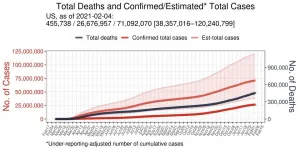INFORMATION:
Facts:
1,700 billion tons of organic matter, built up over thousands of years, are contained in Earth's permafrost. [link: https://cenperm.ku.dk/facts-about-permafrost/]
The amount of carbon stored in permafrost is estimated to be four times more than the total amount of CO2 emitted by humans in modern times.
Microorganisms exist everywhere, in every environment and are central to countless natural processes. In relation to the processes here, climate gases are released into the atmosphere, which is why microorganisms play a key role in climate and climate change.
The study was conducted in the Stordalen mire in Abisko, northern Sweden, and in the laboratory, in a collaboration between the University of Tübingen, the University of Bristol and the University of Copenhagen.
Contact:
Carsten W. Müller
Associate Professor
Department of Geosciences and Natural Resource Management
University of Copenhagen
Mail: cm@ign.ku.dk
Mobile: +45
Michael Skov Jensen
Journalist
The Faculty of Science
University of Copenhagen
Mail:msj@science.ku.dk
Mobile: +45 93 56 58 97
Arctic permafrost releases more CO2 than once believed
There may be greater CO2 emissions associated with thawing Arctic permafrost than ever imagined. An international team of researchers, including one from the University of Copenhagen, has discovered that soil bacteria release CO2 previously thought to be
2021-02-09
(Press-News.org) Rising global temperatures are causing frozen Arctic soil-- permafrost--in the northern hemisphere to thaw and release CO2 that has been stored within it for thousands of years. The amount of carbon stored in permafrost is estimated to be four times greater than the combined amount of CO2 emitted by modern humans.
Research results from an international team, which includes a researcher from the University of Copenhagen among others, suggests that the newly discovered phenomenon will release even larger quantities of CO2 than once supposed from organic matter in permafrost--a pool of carbon previously thought to be bound tightly and safely sequestered by iron.
The amount of stored carbon that is bound to iron and gets converted to CO2 when released is estimated to be somewhere between two and five times the amount of carbon released annually through anthropogenic fossil fuel emissions.
Iron doesn't bind organic carbon after all
Researchers have long been aware that microorganisms play a key role in the release of CO2 as permafrost melts. Microorganisms activated as soil thaws convert dead plants and other organic material into greenhouse gases like methane, nitrous oxide and carbon dioxide.
What is new, is that the mineral iron was believed to bind carbon even as permafrost thawed. The new result demonstrates that bacteria incapacitate iron's carbon trapping ability, resulting in the release of vast amounts of CO2. This is an entirely new discovery.
"What we see is that bacteria simply use iron minerals as a food source. As they feed, the bonds which had trapped carbon are destroyed and it is released into the atmosphere as greenhouse gas," explains Associate Professor Carsten W. Müller of the University of Copenhagen's Department of Geosciences and Natural Resource Management. He elaborates:
"Frozen soil has a high oxygen content, which keeps iron minerals stable and allows carbon to bind to them. But as soon as the ice melts and turns to water, oxygen levels drop and the iron becomes unstable. At the same time, the melted ice permits access to bacteria. As a whole, this is what releases stored carbon as CO2," explains Müller.
The study has just been published in Nature Communications.
Absent from climate models
Although the researchers have only studied a single bog area in Abisko, northern Sweden, they have compared their results with data from other parts the northern hemisphere and expect their new results to also be valid in other areas of permafrost worldwide.
"This means that we have a large new source of CO2 emissions that needs to be included in climate models and more closely examined," says Carsten W. Müller.
Even though carbon stored in permafrost has a major impact on our climate, researchers know very little about the mechanisms that determine whether carbon in soil is converted into greenhouse gases.
"The majority of climate research in the Arctic focuses on the amount of stored carbon and how sensitive it is to climate change. There is a great deal less of a focus on the deeper mechanisms which trap carbon in soil," says Carsten W. Müller.
Researchers remain uncertain about how much extra carbon from soil could potentially be released through this newly discovered mechanism. Closer investigation is needed.
ELSE PRESS RELEASES FROM THIS DATE:
How accurate are first impressions on a first date?
2021-02-09
The high stakes of first dates require would-be partners to make and interpret first impressions. But, can we rely on these first impressions to accurately assess someone's personality? According to researchers from McGill University, the answer is yes, although it may be more difficult than in more casual settings.
Forming an accurate impression of an individual on a first date is important because people often rely on these impressions in deciding whether to pursue a romantic relationship. While previous studies have shown that people can form accurate impressions of new acquaintances in platonic settings - like casual conversations with new classmates - the researchers wanted to find out if the ...
Antiviral proves effective at preventing, treating COVID-19 in lab
2021-02-09
CHAPEL HILL, NC - Publishing their work in Nature, scientists at the UNC School of Medicine and UNC Gillings School of Global Public Health found that the orally administered experimental drug EIDD-2801 halts SARS-CoV-2 replication and prevents infection of human cells in a new in vivo lab model containing human lung tissue.
Separate phase 2 and 3 clinical trials are ongoing to evaluate EIDD-2801 safety in humans and its effect on viral shedding in COVID-19 patients.
The number of new COVID-19 cases continues to rise in many parts of the world, with the highest incidence in the United States. Although some highly efficacious vaccines have been ...
How has Covid-19 affected the treatment of osteoporosis?
2021-02-09
A global survey of healthcare providers by the International Osteoporosis Foundation (IOF), the National Osteoporosis Foundation (NOF) and the European Society for Clinical and Economic Aspects of Osteoporosis, Osteoarthritis and Musculoskeletal Diseases (ESCEO) has revealed unprecedented effects of the Covid-19 pandemic on worldwide healthcare delivery for osteoporosis.
Osteoporosis is a chronic, age-related disease which is associated with life-changing fragility fractures. Approximately 740,000 people lose their lives following hip fractures every year.
The survey report is based on online questionnaires completed from April to June 2020 by 209 healthcare providers in 53 countries: 28% from Europe, 24% from North America, and 19%, 17% and 12% from the Asia-Pacific, Middle ...
COVID-19 infections in the U.S. nearly three times greater than reported, model estimates
2021-02-09
DALLAS - Feb. 8, 2021 - World health experts have long suspected that the incidence of COVID-19 has been higher than reported. Now, a machine-learning algorithm developed at UT Southwestern estimates that the number of COVID-19 cases in the U.S. since the pandemic began is nearly three times that of confirmed cases.
The algorithm, described in a study published today in PLOS ONE, provides daily updated estimates of total infections to date as well as how many people are currently infected across the U.S. and in 50 countries hardest hit by the pandemic.
As of Feb. 4, according to ...
10-year study shows elevated suicide risk from excess social media time for teen girls
2021-02-09
As teens' use of social media has grown over the past decade, so too has the suicide rate among younger people, with suicide now being the second leading cause of death among those ages 10 to 34. Many have suggested that social media is driving the increased suicide risk, but because social media is still relatively new, it's been difficult to determine its long-term effects on mental health.
In the longest study to date on social media use and suicidality, BYU research recently published in the Journal of Youth and Adolescence now offers some answers.
Through ...
MSK researchers learn what's driving 'brain fog' in people with COVID-19
2021-02-09
One of the dozens of unusual symptoms that have emerged in COVID-19 patients is a condition that's informally called "COVID brain" or "brain fog." It's characterized by confusion, headaches, and loss of short-term memory. In severe cases, it can lead to psychosis and even seizures. It usually emerges weeks after someone first becomes sick with COVID-19.
In the February 8, 2021, issue of the journal Cancer Cell, a multidisciplinary team from Memorial Sloan Kettering reports an underlying cause of COVID brain: the presence of inflammatory molecules in the liquid surrounding the brain and spinal cord (called the cerebrospinal fluid). The findings suggest that anti-inflammatory drugs, such as steroids, may ...
Odds of leaving military double after sexual assault, report finds
2021-02-09
Exposure to sexual assault in the U.S. military doubled the odds that a service member would leave the military within 28 months, and sexual harassment was associated with roughly 8% of all military separations during this same time period, according to a new report from the RAND Corporation.
Specifically, the report estimates that sexual assaults were associated with 2,000 more separations than would normally be expected, and another 8,000 separations were associated with sexual harassment.
"Sexual assault and sexual harassment are associated with a wide range of harms to individual service members, but this study highlights another negative impact of these crimes - higher rates of attrition and associated harms to force readiness." said Andrew ...
A new type of university is emerging to meet the challenges of today
2021-02-09
The world is changing rapidly and in order to serve the human population dealing with those changes, American universities need to change, too. In fact, their role is to model the resiliency that all institutions need to embrace, according to Arizona State University President Michael M. Crow.
While many leading universities are poised to advance society and help respond to the challenges of disruptive change through their traditional role in education and discovery, many face a number of barriers that make them less prepared to respond to the rapidly changing conditions and the demands they create.
What is emerging is a new type of university, one that steps beyond the American research university model and ...
Mean or nice? These traits could make or break a child's friendships
2021-02-09
Not all friendships are created equal. Some friends get along; others struggle to avoid conflict. Conventional wisdom holds that the tenor of a friendship with someone who is nice differs from that with someone who is mean, such that the former discourages negative interactions whereas the latter aggravates them. Although it is logical to assume that children who are mean have friendships characterized by growing strife and that children who are nice report little of the same, these assumptions have not yet been tested in the real-world friendships of children.
Researchers from Florida Atlantic University's Charles E. Schmidt College of Science are the first to conduct a longitudinal study to examine the extent to which being "nice" (prosocial behavior) and being "mean" (relationally aggressive ...
Traumatic stress in childhood can lead to brain changes in adulthood: study
2021-02-09
A new study from University of Alberta researchers has shown that traumatic or stressful events in childhood may lead to tiny changes in key brain structures that can now be identified decades later.
The study is the first to show that trauma or maltreatment during a child's early years--a well-known risk factor for developing mental health conditions such as major depressive disorder in adulthood--triggers changes in specific subregions of the amygdala and the hippocampus.
Once these changes occur, researchers believe the affected regions of the brain may not function as well, potentially increasing the risk of developing mental health disorders as adults during times of stress.
"Now ...
LAST 30 PRESS RELEASES:
First Editorial of 2026: Resisting AI slop
Joint ground- and space-based observations reveal Saturn-mass rogue planet
Inheritable genetic variant offers protection against blood cancer risk and progression
Pigs settled Pacific islands alongside early human voyagers
A Coral reef’s daily pulse reshapes microbes in surrounding waters
EAST Tokamak experiments exceed plasma density limit, offering new approach to fusion ignition
Groundbreaking discovery reveals Africa’s oldest cremation pyre and complex ritual practices
First breathing ‘lung-on-chip’ developed using genetically identical cells
How people moved pigs across the Pacific
Interaction of climate change and human activity and its impact on plant diversity in Qinghai-Tibet plateau
From addressing uncertainty to national strategy: an interpretation of Professor Lim Siong Guan’s views
Clinical trials on AI language model use in digestive healthcare
Scientists improve robotic visual–inertial trajectory localization accuracy using cross-modal interaction and selection techniques
Correlation between cancer cachexia and immune-related adverse events in HCC
Human adipose tissue: a new source for functional organoids
Metro lines double as freight highways during off-peak hours, Beijing study shows
Biomedical functions and applications of nanomaterials in tumor diagnosis and treatment: perspectives from ophthalmic oncology
3D imaging unveils how passivation improves perovskite solar cell performance
Enriching framework Al sites in 8-membered rings of Cu-SSZ-39 zeolite to enhance low-temperature ammonia selective catalytic reduction performance
AI-powered RNA drug development: a new frontier in therapeutics
Decoupling the HOR enhancement on PtRu: Dynamically matching interfacial water to reaction coordinates
Sulfur isn’t poisonous when it synergistically acts with phosphine in olefins hydroformylation
URI researchers uncover molecular mechanisms behind speciation in corals
Chitin based carbon aerogel offers a cleaner way to store thermal energy
Tracing hidden sources of nitrate pollution in rapidly changing rural urban landscapes
Viruses on plastic pollution may quietly accelerate the spread of antibiotic resistance
Three UH Rainbow Babies & Children’s faculty elected to prestigious American Pediatric Society
Tunnel resilience models unveiled to aid post-earthquake recovery
Satellite communication systems: the future of 5G/6G connectivity
Space computing power networks: a new frontier for satellite technologies
[Press-News.org] Arctic permafrost releases more CO2 than once believedThere may be greater CO2 emissions associated with thawing Arctic permafrost than ever imagined. An international team of researchers, including one from the University of Copenhagen, has discovered that soil bacteria release CO2 previously thought to be


